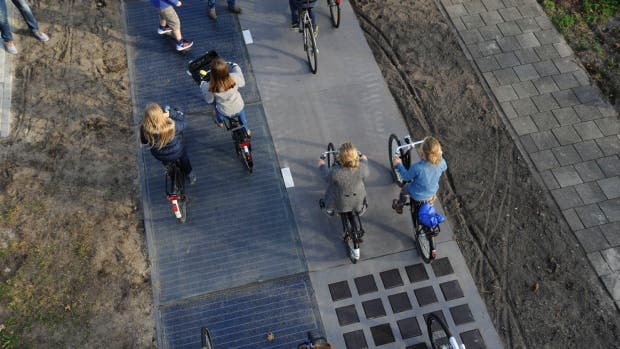Only six months ago, a 230-foot strip of road was covered in solar panels in the Netherlands. Since then, some 3,000 kilowatt-hours of energy were produced or enough to power one Dutch home for a whole year. These news came as a surprise even to the developers of SolaRoad, as the project has been dubbed.

“We did not expect a yield as high as this so quickly,” said Sten de Wit, spokesman for the public-private partnership project, in a statement that deemed the first half-year of a three-year pilot a success.
“If we translate this to an annual yield, we expect more than the 70kwh per square meter per year,” de Wit said.
The solar panels were installed underneath a bicycle road that linked the two suburbs of Krommenie and Wormerveer, in Amsterdam. The SolaRoad is made of concrete paving slabs embedded with ordinary solar panels. The solar panels are protected by a centimetre-thick layer of transparent, skid-resistant tempered safety glass that can support bicycles and vehicles. As such, these aren’t exactly your typical rooftop solar panel, with all the pros and cons that come with them.
The test run aims to see whether SolaRoad is just as resistant as asphalt and doesn’t annoy pedestrians and cyclists with any reflections. The experiment will continue for another two and a half years to see how well the panels fair and how much electricity can be generated during this time frame, considering all the busy bike traffic (it’s Amsterdam, remember!). The ultimate goal is to fit these solar panels inside the roads for automobiles, which should be more challenging considering the traffic. In fact, this is a major concern. Will the glass handle the pressure exerted by tens of thousands of cars racing past it? Safety’s first, and SolaRoad officials are testing these sort of scenarios.
So far, more than 150,000 cyclists have zipped over the solar-generating part of the bike path. SolaRoad says they “hardly notice it is a special path.” With this in mind, it’s time to add another tidbit to the growing list of solar energy facts.
Personally, I find it all a bit overkill. The three-year project costs 3.5-million Euros, and while I understand the price tag covers research and developments costs as well, it’s still a stinger! Also, once spring came the temperature fluctuations caused the surface of the protective glass to peel off. This might be fixed so as to not happen in the future – not after every winter at least. But imagine having hundreds of kilometers of these panels under the road, only to close them for maintenance every year. That’s annoying, not to mention costly. Maybe we should first cover every available inch on our rooftops first.


